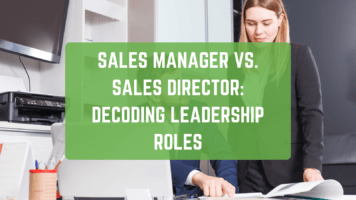You send one sales email with a surge of hope that you’ll hear back from your prospect. And then? Crickets!
Is it time to give up? Hardly. No matter your industry or offering, most sales require five to twelve contact points in the sales pipeline before a deal is made.
A friendly follow-up email can make all the difference.
In this blog, we’re covering the foundational tips you need to understand why you’d want to send a follow-up email after no response, what best practices to follow, the most crucial information to include in your follow-ups, and the top mistakes to avoid.
We’ve also gathered five follow-up email templates from top-performing salespeople in our network to give you a head start on your follow-up email strategy.

5 Answers to the Question, “Why Send a Follow-up Email After No Response?”
Reason #1 to Send a Follow-up Email After No Response:
Follow-up emails often have higher open rates than first-time emails. There’s a chance the prospect remembers your name or saw your first email and meant to follow up. A courteous reminder can prompt a response.
Reason #2 to Send a Follow-up Email After No Response:
Prospects appreciate quality customer service — that starts before the sale. How you speak to and treat your prospects shows them how you’ll speak to and treat them after a sale, too. Sales follow-up emails create more than an opportunity to make a sale. They also establish your professional reputation with prospects.
Reason #3 to Send a Follow-up Email After No Response:
Polite persistence shows your genuine interest in the prospect. If you don’t follow up, chances are someone else in your industry with a similar product or service will. A little determination goes a long way in keeping you top of mind.
Reason #4 to Send a Follow-up Email After No Response:
Customized sales follow-up emails give you a chance to clarify. Suppose you find areas where a prospect might have misunderstood you or been left with unanswered questions after reading your initial email. In that case, this is your opportunity to offer answers. Be mindful of using an automated follow-up sequence that doesn’t allow for customization.
Reason #5 to Send a Follow-up Email After No Response:
Nurturing relationships takes time, and a polite follow-up email starts the building process early on. Maintaining respectful contact makes an impression on prospects and develops rapport, a priceless asset as you move forward in your sales process.
5 Best Practices for Sending a Follow-up Email After No Response
Follow-Up Best Practice #1: Start With a Compelling Subject Line
The one determining factor for whether or not a prospect will open up your follow-up email — or any email for that matter — is a relevant and curiosity-piquing subject line. Your goal is to encourage the prospect to open your email with genuine interest, not with their defenses already up. Keep this line cordial and inviting.
Follow-Up Best Practice #2: Assume the Best of Your Prospect
Throughout your email, maintain a polite and respectful tone. This is much easier to do if your mindset about the prospect is positive and assumes the best of them. That means expressing an understanding that they’re busy and not taking their lack of initial response personally.
Follow-Up Best Practice #3: Value Your Prospects Time
A simple follow-up email can be just 50 words long. Anything over 100-200 words could be too long for your prospect. Keep your email concise so that your prospect doesn’t waste their time guessing who you are, why you’re emailing, or what you want them to do next.
Follow-Up Best Practice #4: Highlight the Benefits
Keeping the content of your email value-oriented will help your prospects quickly understand the benefit they will gain by responding. Highlight why this conversation or opportunity to connect with you might be important to them.
Follow-Up Best Practice #5: End with a Clear CTA
The easier it is for a prospect to reply to your email or respond to your next steps, the better. All you’re looking for is a ‘yes’ to getting on a call with you (or whatever action comes next in your sales follow-up email strategy), so don’t distract your prospect from the action you want them to take.
→ How Long Should You Wait to Follow Up After No Response?
The timing of your follow-up email can vary based on the context. However, a general guideline is to wait about 3-7 business days before sending a polite follow-up email. If it’s a time-sensitive matter, you may want to follow up sooner, but be mindful not to appear overly aggressive.
5 Key Pieces of Information to Include in a Follow-up Email After No Response
Key Follow-Up Info #1: A Clear Connection
When you write your first email to a prospective customer, keep your follow-up in mind. It should be easy for the recipient to connect your first email to your second. Mention the subject and date of the last email in your follow-up.
Key Follow-Up Info #2: A Gentle Reminder of Your Reason
Don’t assume that the recipient read or remembers your first email. Restate briefly your purpose and what you’re hoping to accomplish so that the email stands on its own and, hopefully, inspires a response or a re-read of your first email.
Key Follow-Up Info #3: A Value Proposition
Everyone wants to know — what’s in it for me? Make it clear to your prospects why they will benefit from responding to your follow-up email. This is most often the benefit of the ‘next step’ you’ll help them with, not necessarily the value proposition of your entire offering.
Key Follow-Up Info #4: One Call to Action
Present your prospect with one action you would like them to take in response to your email. Whether that’s replying, scheduling a call, or something else — be specific and stick to one CTA per email. Open-ended emails or those with too many options can be overwhelming and get your messages ignored.
Key Follow-Up Info #5: Your Contact Details
Ensure your name, phone number, email, and any other contact information relevant to your follow-up email strategy is easy to read and find in your email signature and, if appropriate, in the body of your email.
5 Mistakes to Avoid When Sending a Follow-up Email After No Response
Mistake #1: Coming across as rude
Your tone is fundamental in writing because even a few words that imply disrespect can instantly turn off a potential customer. Avoid any language that seems pushy, demanding, or aggressive, and opt for respect and patience in your words instead.
Mistake #2: Focusing on YOU
Your recipient is focused on themselves — what they want and need. If your email just talks about your company or credentials, you’ll likely lose your lead. Share how your message benefits them if you want to engage your potential customers in a genuine and helpful exchange.
Mistake #3: Copying-and-pasting generic messages
Business owners get cold emails every day, and generic messages are likely to get deleted before they’re even fully read — they’re easy to spot! Tailor your follow-up to reflect the context and any connection you have with the recipient.
Mistake #4: Spamming with emails
Sending too many follow-ups, sending them too soon, or in too close of succession almost guarantees you’ll be seen as annoying spam instead of the advocate of a valuable service. Err on the side of discretion and be politely persistent.
Mistake #5: Using high-pressure tactics
Express your frustration to a friend, not to your potential client. Any undertone of disappointment, shame, or blame in your follow-up email won’t gain you any traction with a prospect. Avoid negativity and high-pressure tactics. Maintain your professionalism.
5 Follow-Up Email Templates
Copy the text in the box to simplify your next follow-up email.
Follow-Up Email After A Meeting
- [INSERT LIST]
At [YOUR COMPANY NAME], we’re committed to [INSERT SERVICE] that exceeds your expectations. Our reputation for delivering results speaks for itself, with numerous success stories in similar industries. Please feel free to reach out with any questions or to schedule another discussion at your convenience.
Warmest regards,
[YOUR NAME]
Follow-Up Email After The First Discussion
I wanted to follow-up and see if you’ve made any decisions on pursuing this partnership further? If not, I’m happy to discuss further and provide any information you need to make your decision.
Best,
[YOUR NAME]
Follow-Up Email After No Response
I believe [INSERT SERVICES] at [YOUR COMPANY NAME] could help your company achieve [INSERT RESULTS]. Please feel free to reach out with any questions or to schedule a discussion at your convenience.
Looking forward to hearing from you,
[YOUR NAME]
Follow-Up Email After A Proposal
Thanks,
[YOUR NAME]
Follow-Up Email After A Missed Call
Thanks,
[YOUR NAME]
Ready to take your sales email strategy to the next level? Our network of top-performing sales professionals is ready to help, and we’re ready to connect you with the perfect new team member. Contact us today, share a little bit about your sales staffing needs, and we’ll be in touch soon!
relpost-thumb-wrapper
Related posts
close relpost-thumb-wrapper
Latest posts by Kyle Fletcher (see all)
- Employee Referral Programs: Is Your Next Sales Rep Just One Connection Away? – December 27, 2023
- Don’t Make These 7 Offer Stage Mistakes – December 19, 2023
- Mastering Sales Management: 8 Sales Leadership Qualities Required for Success – December 15, 2023




